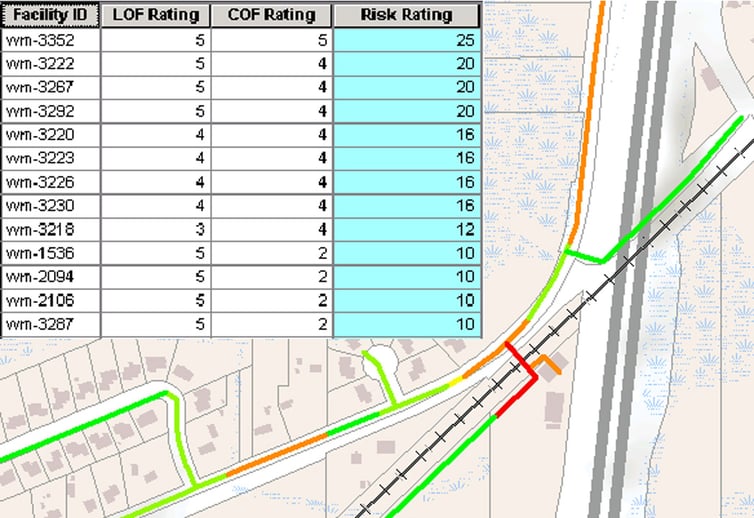Being more efficient comes with today’s need to persevere over limited resources. Using analytics can help increase efficiency and deliver significant cost savings.
Every organization has limited resources. What can you do about it? Use analytics to be more efficient and make data-driven decisions. Organizations across the world are using Geographic Information System (GIS) technology to implement risk-based planning and fully understand asset maintenance costs.
1. Risk-based planning
When an asset fails there can be significant economic, environmental and societal consequences. Many organizations perform Physical Condition Assessments (PCAs) of their assets to determine the likelihood of an asset failing. While effective, PCAs can be very costly. To be more efficient with resources, organizations are utilizing GIS technology and analytics to develop risk-based planning frameworks.
Risk-based planning is a proactive measure that looks at asset likelihood of failure (LOF) multiplied by the asset consequence of failure (COF). The higher the LOF and COF, the greater the risk of an asset failing. Higher risk assets can then be prioritized for PCAs, repair or replacement. Targeted PCAs, along with proactive repair or replacement of infrastructure through risk-based planning can help avoid failures, their associated consequences and improve efficiency with limited resources.

An example of a risk matrix with the likelihood of failure (LOF) and consequence of failure (COF).
A GIS is critical to risk-based planning. It helps aggregate and integrate the data used to determine LOF, COF and risk ratings. For example, GIS can overlay water main material data with corrosive soil data as a LOF variable. Similarly, GIS can help determine COF variables by analyzing which mains serve a hospital versus a small residential neighborhood.

GIS can integrate and analyze data used for a risk-based approach and provides a system to collect, manage and visualize information.
Physical Condition Assessment (PCA) is a great way to determine the health of an asset. However, employing a PCA on each asset in an organization can be quite costly. Instead, a combination of risk-based planning and a PCA can be used to verify the likelihood of failure probabilities and further refine the risk-based models. Will this approach result in fewer asset failures? Not necessarily, but it will result in fewer high-risk asset failures and more efficient allocation of limited resources.
2. Asset maintenance cost
Gone are the days of sending staff out to repair an asset and wondering what the associated cost of those repairs are. Data-driven decision-makers use GIS along with asset management software to associate labor and material costs from maintenance activities to specific assets. This analysis can identify trends for particular assets and enable leaders to make informed, data-driven decisions.
Asking the right questions leads to collecting the right data:
- Are staff having to repair the same asset repeatedly?
- How does the maintenance activity schedule and cost for an asset compare to similar assets?
- Is there a particular asset type or characteristic with higher maintenance costs?
- What is the cost of the current maintenance pattern versus replacing the asset?
While some aspects of asset management will always be reactive, analysis of existing data can provide significant cost savings over time and utilize limited resources more efficiently.

Analyzing maintenance costs per asset provides a framework to determine rehab, replacement and capital improvement plans. As this graphic shows, certain assets have varying costs associated with them.
Risk-based planning and data-driven decisions begin with an upgrade
If you’re using outdated technology and methods to manage and understand your infrastructure, there’s a better way. Connect with Andrew Niederhauser to learn more about establishing a data-driven approach to asset management, which is helping organizations of all sizes, public and private, turn big data into big savings.
About the Expert

Andrew Niederhauser is a GIS manager who helps organizations of all sizes leverage GIS technology.

.png?width=113&name=SEH_Logo_RGB%20(1).png)
